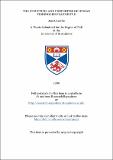Files in this item
The structure and properties of human fibrinogen fragment D
Item metadata
| dc.contributor.advisor | Kemp, Graham | |
| dc.contributor.author | Lawrie, Jan Sloane | |
| dc.coverage.spatial | 289 p. | en_US |
| dc.date.accessioned | 2018-07-05T08:35:13Z | |
| dc.date.available | 2018-07-05T08:35:13Z | |
| dc.date.issued | 1980 | |
| dc.identifier.uri | https://hdl.handle.net/10023/14953 | |
| dc.description.abstract | (1) Three molecular weight forms of fragment D were isolated from a plasmic digest of human fibrinogen. Further heterogeneities within the preparation were revealed by NH2-terminal amino acid analysis and by digestion studies performed in the presence of 2 N-urea; the existence of conformationally different forms of the fragment D molecule is proposed. (2) Plasmic digestion of fibrinogen in the presence of 2 md-Ca2+ produced a homogeneous high molecular weight preparation of fragment D (designated DCa 2+) In the absence of Ca2+ or in the presence of EDTA, two lower molecular weight forms of fragment D, each containing a more degraded constituent γ chain, were identified. In the presence of 2 N-urea only slight plasmic degradation of fragment DCa2+ occurred. (3) Increased SDS-gel electrophoretic mobilities were demonstrated for the fragments D and Y prepared from fibrinogen in the presence of Ca2+. An anomalous electrophoretic mobility pattern was also described for the constituent γ chain of fragment DCa2+ and of fibrinogen exposed to Ca2+. It is suggested that Ca2+ bound to the constituent γ chain of fibrinogen and fragment D forms an intra chain Ca2+ -bridge towards the COOH-terminus thereby maintaining a 'hook-like' conformation. This form of fragment D, it is proposed, exhibits a decreased susceptibility to plasmic attack and an anomalously low electrophoretic mobility. (4) A method was developed employing ion-exchange chromatography and gel filtration for the preparation and isolation of fragment D both in the presence and absence of free Ca2+. (5) Studies employing purified samples of each type of fragment D confirmed that the two molecules differed in the extent of degradation of the constituent γ chain at the COOH-terminus. Furthermore an influence of Ca2+ on the charge heterogeneity of fragment D preparations was concluded from isoelectric focussing studies. (6) The proposal of a compact and thereby stable structure for the fragment DCa2+ molecule was strengthened by the results obtained from studies employing chemical crosslinking reagents and the technique of ultracentrifugation. (7) The possibility that serine, glycine and glutamate amino acid residues are located in the region of the γ chain associated with the binding of Ca2+ was suggested from amino acid analysis of fragment D. | en_US |
| dc.language.iso | en | en_US |
| dc.publisher | University of St Andrews | |
| dc.subject.lcc | QP93.5L2 | |
| dc.subject.lcsh | Blood--Coagulation | en |
| dc.title | The structure and properties of human fibrinogen fragment D | en_US |
| dc.type | Thesis | en_US |
| dc.type.qualificationlevel | Doctoral | en_US |
| dc.type.qualificationname | PhD Doctor of Philosophy | en_US |
| dc.publisher.institution | The University of St Andrews | en_US |
This item appears in the following Collection(s)
Items in the St Andrews Research Repository are protected by copyright, with all rights reserved, unless otherwise indicated.

